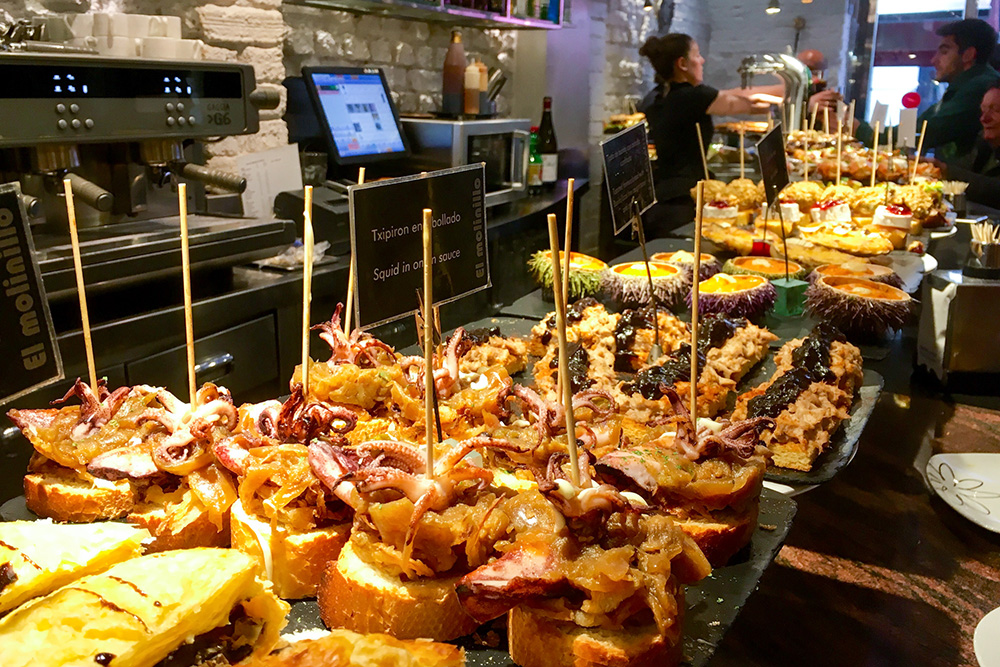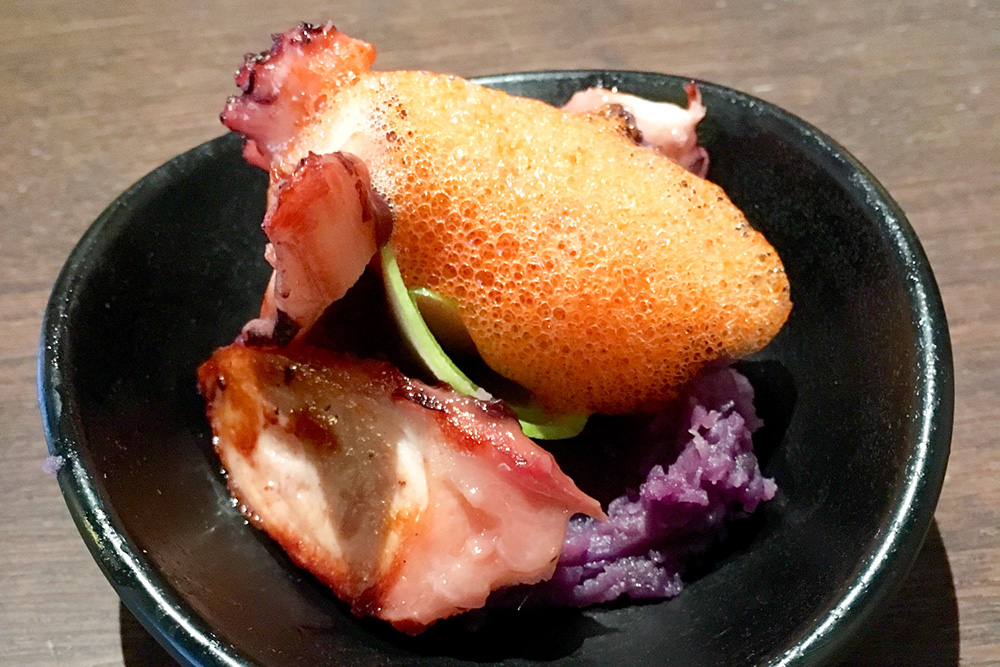The Basque region stretches from southwestern France into northeastern Spain. The region's language is altogether different from Spanish or French, and confounds linguists to this day as to its origins. Basques also possess a strong independent cultural identity and spirit: They’re hard-working, yet they know just how to relax. And for the hungry among us, the region's uniqueness is reflected in the Basque approach to food and eating.

Bartenders and trays of pintxos at the ready in San Sebastian.
Our personal introduction to Basque food happened years ago in Barcelona. In search of dinner one evening, we passed by what seemed at first glance an ordinary tapas bar bursting with party-goers. The energy inside was magnetic, yet overwhelming. Casting fear and culinary disorientation aside, we threw ourselves into the fray.
Examining more closely, we noticed the bar, covered in huge platters of tapas (bite-sized eats). Other platters circulated, moving overhead, exchanging hands from one group to another, as if crowd surfing the bar. Most bites were served on slices of bread and all were skewered with a toothpick. As if an invitation to a special world, the bartender offered us two plates and a bottle of Basque sparkling wine known as txakoli. With the help of another customer, we eventually sorted out this game. Whenever a tray passed by with something tasty, we took what we wanted. When we were finished, the bartender counted toothpicks — and bottles — and gave us the bill.
“What a brilliant way to eat,” we thought. Flavour. Variety. Community. We experienced it all. We only later discovered it was a Basque restaurant, serving Basque-style tapas (called pintxos) in a Basque-style of eating and pintxo bar-hopping called txikiteo.
After that night — and after reading Mark Kurlansky’s Basque History of the World — our curiosity about Basque cuisine and culture grew. We are not at all embarrassed to admit that, while planning to walk the Camino de Santiago last year, one of the primary factors in choosing the Camino del Norte (Northern Route) was our desire to experience Basque food.
With Basque cuisine, it’s not just what you eat, but how you eat it. The manner in which pintxos are displayed encourages experimentation, and is conducive to noshing on small bites for hours on end. The aim, it seems, is to nourish yourself not only with the food, but also with the company of your friends and family.

If it won’t break it, then put a stick through it.
The bar-hopping mentality of txikiteo encourages you to try different pintxos not only from one bar or restaurant, but across several, all in one evening. This approach adds movement to an evening exactly when it’s needed.
Basque food 101
The essence of Basque food is simple, fresh, local ingredients in complementary — but sometimes unexpected — combinations of savoury and sweet. The cuisine draws from the region’s fertile land and bountiful sea, meaning plenty of cured and seared meats from inland farms as well as seafood from the coast.
In recent years, Basque chefs have experimented with these characteristics to create unusual and innovative fusion dishes — so much so that the Basque town of San Sebastian in northern Spain features the highest number of Michelin-starred restaurants per capita in the world. Dishes are approachable and not terribly expensive, so you can still eat remarkably well in the region without spending a fortune.

Basque pintxos go fusion in San Sebastian. A little party for the mouth with just few Euros.
Basque coastal hillside wineries produce a number of light and cuisine-fitting white wines and the aforementioned txakoli, a dry, high-acidity sparkling wine that pairs well with local food. Other white and red wines from across Spain — at various pricing tiers — will also be available, in a price-to-quality ratio that reaffirms Basque sensibility. As you head inland, the Basque seaside cliffs yield to apple groves, the source of locally-made cider. This cider is nothing ordinary, either, particularly in the way it’s served — or, rather, aimed from on high — into one’s glass.
Pintxos and the txikiteo culture
While the rest of Spain dines on tapas (small plates), the Basque region eats pintxos. The name pintxo is derived from the Spanish word pinchar, which means to poke or stab, as there is usually a toothpick running from the top of the bite through to its base, which is often a thin slice of bread. This method serves not only as a practical way of holding food together, but also as a simple way — via empty toothpicks at the end of the meal — for restaurants to account for how much you’ve eaten.
Pintxos are often displayed on long, rectangular trays on the bar counter. Even in the smallest pintxo bars, it’s not unusual to see more than a dozen different types on offer — from the simplest of cured meats stacked on olive oil grilled bread to fancy options like olive oil foam atop salted cod. Although small in stature, pintxos pack a punch when it comes to both flavour and mouthfeel.
Don’t forget to ask at the bar if there are custom, hot menu items on offer. These can often turn out to be gourmet mini-meals: Some of our favourites included local braised meats that melt in your mouth, txipirones (baby squid) in their own ink, braised scallops in a savoury reduction, warmed foie gras slices on toast, and baked sea urchin.
Of course, the whole experience is also a feast for the eyes, lending itself to over-ordering and gluttony. We recommend you resist the urge to pile it all on your plate at once and notice the pace of others — locals especially — around you, while keeping in mind that another round of something fresh is just about to emerge from the kitchen.
So, you select only a couple of pintxos — either by taking them yourself or asking the bartender to create a plate for you. Take your time, perhaps with a glass of cider or sparkling wine. Then, return to the bar in stages, seeking different options and different flavour combinations. And after a round or two at one pintxo bar, consider a change of venue. The system is designed for experimentation.
Bonus tip: Eat some Basque burnt cheesecake
Be sure you don’t fill up too much on pintxos: we recommend ending your txikiteo outing on a sweet note, with a slice of baked cheesecake and glass of sweet sherry. If you find yourself in San Sebastian, La Viña is your place for arguably the region’s best cheesecake. With the consistency of a light baked custard, it's less sweet than the dense cheesecakes we’re accustomed to. We visited two nights in a row. It was that good.
Getting there
Ready for a bite? G Adventures can get you there. Check out our small group tours to Spain — to Basque and beyond — here.























